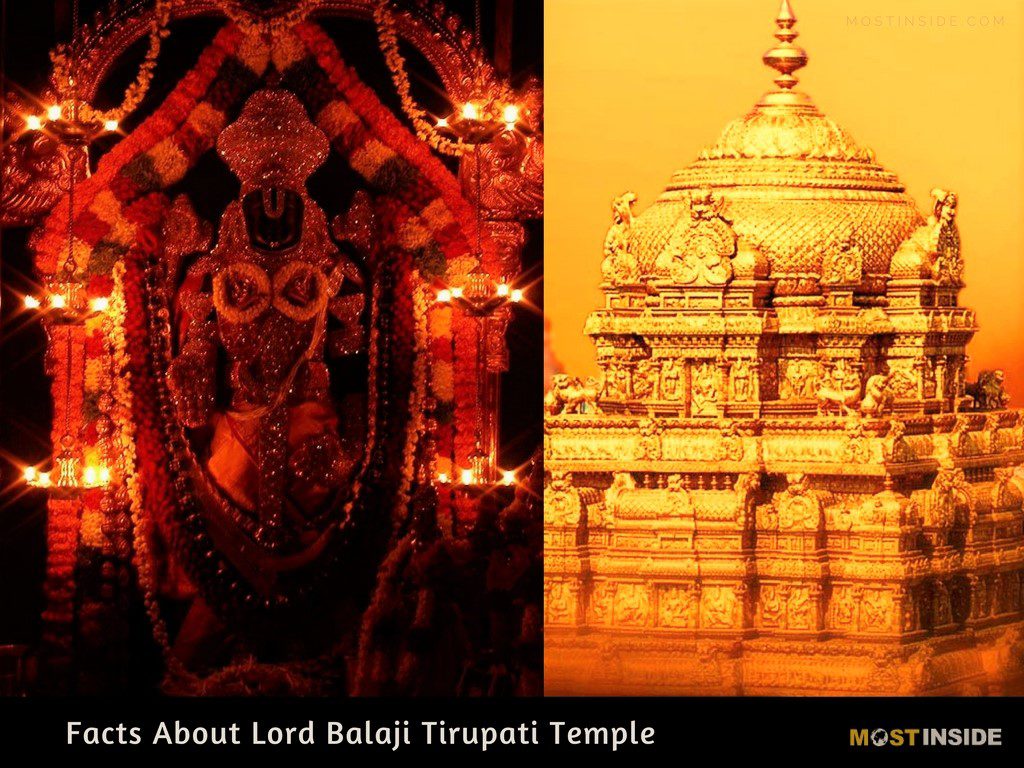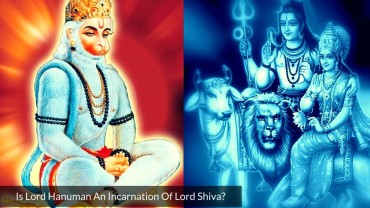20 Surprising Lesser Known Facts About Lord Balaji Tirupati Temple
This post was last updated on January 4th, 2025

Tirupati Balaji Temple is known as one of the most sacred temples in Hinduism and in entire India. Tirupati temple is located around 10 kilometres north-west of Tirupati in Chittoor district, Andhra Pradesh. This temple is the renowned place chosen by Lord Vishnu as his alternative celestial home, Vaikuntha. Balaji, Tirupati temple is situated in the lap of the Tirumala hill town and the temple is the home of Lord Balaji who is an incarnation of Lord Vishnu, hence Lord Balaji is also known as Lord Venkateswara and this temple is also popularly known as Sri Venkateswara Swamy Temple.
This temple has some fascinating and surprising facts that keep attracting tourists as well as people from other religion background. The Tirumala hill shrine comprises of seven hills named as Seshadri, Neeladri, Garudadri, Anjanadri, Vrishabhadri, Narayanadri, and Venkatadri. The central temple of Tirumala lies on the seventh hill called Venkatadri for which the temple is also called as “The Temple of Seven Hills”. Lord Sri Venkateswara Swamy is also known as Balaji and Govinda who is considered as the presiding demiurge of this holy Tirumala Temple.
Let’s reveal the surprising yet lesser known facts about Lord Balaji as well as Tirupati Temple.
1. Tirumala Hill Ranges depict the face of Lord Balaji
One of the most shocking and amazing fact that anyone could believe is the Tirumala Hills that is located 1 km north of the temple is a natural arch and is a geological magic which represents the facial structure of Lord Balaji itself which is also known as Silathoranam in Telugu where ‘Sila’ means the rock and ‘Thoranam’ means an arch. It is estimated that the arch is 8 m in width and 3 m in height.
2. Stick at the right side of main entrance
At the main entrance of Tirupati Balaji Temple, there is a stick to the right side which was used by Ananthaalvar to hit Venkateswara Swamy when he was a small boy and once his chin was hurt by that stick and since then the tradition and practice of applying sandalwood paste (Chandan) on Swamy’s chin started.
3. Ritual of hair sacrifice, Mokku
There’s a small old story related to this hair sacrifice ritual named Mokku. Once Balaji lost some of his hair after getting hit by a shepherd, Neela Devi who was a Gandharva princess. After realizing this, Neela Devi cut a small portion of her hair to implant it on Balaji’s head and Lord Balaji promised her that all his devotees who will ever come to his shrine and render their hair to him will ultimately be received by her. And since then many devotees render their hair to the Lord later they are auctioned at the time of dense gathering due to special occasions.
4. Secret village is the source of flowers, milk and butter
All Gods are worshipped by flowers and at the Tirupati Balaji Temple, these flowers come from a secret village which is never seen and discovered by any outsider and even they are not allowed to get into that secret village. The villagers are the only people who are allowed to that village which is 22 km away from the temple. Not only flowers, other items like ghee, butter, milk, bilva leaves, banana leaves are also provided by that secret village.
5. Statue of Lord Balaji at the right side corner of Garba Gudi
All the visitors who have successfully worshipped Lord Balaji at Tirupati have to say that Lord Venkateswara Swamy idol appears to be standing straight at the centre of the garba gudi, the innermost sanctum but in real the statue stands at the right side corner of the garba gudi which can be noticed only from standing outside. Surprising, isn’t it?
6. Tirupati Temple Dravidian Architecture
The entire city of Tirupati has several temples which have a specific shape of pyramid towers and Tirupati temple is popular for its exotic architectural style of Dravidian culture whose construction was commenced around 300 AD built of sandstones, soapstones and granites.
7. Affluent and most visited temple
According to the latest estimations, the Tirupati temple has its gold reserves and almost 52 tonnes of gold ornaments worth over INR 37,000 crores approximately. Every year around 3,000 kilograms of gold are received from pilgrims in Hundi with nationalized banks which is referred as gold reserve deposits. Currently, the approximate annual income of this wonderful temple is around $ 600 Million which means that the temple has its daily earning of $ 1.5 Million. The temple is also one of the most visited sacred place in the entire world at an average rate of about 50,000 to 1,00,000 pilgrims on a daily basis for visiting this place. And this number increases immensely on festivals and special occasions. The temple gets an average of 30 Million to 40 Million visitors every year.
8. Huge daily program of food service
The Tirumala Temple arranges a vast daily programme of food service called “Nitya Anna Danam” conducted by TTD serving 1,20,000 people approximately on a daily basis.
9. Tirupati Laddu is geographical indicator
Devotees of Tirupati temple can never go back without getting the Srivari laddu prasadam which is the most delicious and best naivedyam of Lord Balaji. The renowned sweet is enriched with dry fruits and nuts which is a registered Geographical Indicator (GI) after a serious issue of black market which was developing around the preparation and distribution service of these laddus.
10. Lord Balaji statue has real hair
It is said and believed that Lord Balaji idol has real hair which never tangles and are super silky smooth always.
11. Waterfall behind Lord Balaji idol
A very surprising fact about Lord Balaji Tirupati temple is that there is a waterfall behind Lord Balaji idol and all the flowers that are used for worshipping Lord’s idol are thrown in the waterfall. One can hear the sound of roaring ocean placing an ear on the back of Lord’s idol.
12. Laxmi Devi on the heart of Lord Balaji idol
Lakshmi Devi is said to be present on the heart of Swamy Venkateswara. According to the temple pandits and Brahmins on Thursdays, during Nija Roopa Darshanam, Lord Balaji is decorated with white wood paste and when this paste is taken out, the imprint on Laxmi Devi remains which is later sold by the temple authorities.
13. Earthen lamps (Deepa) are lighted from an uncertain long time
The earthen oil lamps (deepam) that are used in worshipping Lord Balaji are always placed in front of the Balaji idol and the lamps never get put off as it is unknown till yet when these lamps were lit up for the first ever time. It is believed that they were lit up thousands of years ago and will remain the same forever.
14. Lord Venkateswara Swamy had once appeared in real
It is believed and said that in 1800, the temple was closed for 12 years as one King had punished 12 people for some crime by killing them and hanging them on the temple walls and it was the time when Vimana Venkateswara Swamy, Lord Balaji himself appeared in real.
15. Back of Lord Balaji idol never dries
It is said that no matter how many times, the back of the idol of Lord Balaji is dried up and cleaned, it remains wet and moist always.
16. Flowers offered to Lord comes out at Verpedu
When someone deceases, like one does not see behind and lights the fire, similarly, the flowers that are removed from Swamy are thrown at the back of the idol and the pandits do not look at the back of the Lord Balaji that entire day. All these flowers are said to seen coming out at a place called Verpedu that is 20 km from Tirupati.
17. Tirumala Hills entrance arch resembles a serpent’s hood
The Tirumala Hills entrance arch resembles the hood of a serpent which is considered unique in the world. It is also said that the main deity in Balaji Tirupati temple is of the same height as the height of the entrance arch.
18. Chemical Green Camphor cause no damage to the idol
The idol of Lord Balaji is adorned with a highly volatile chemical that is raw camphor or green camphor (Pachai Karpooram) derived from Cinnamomum camphora tree. When this chemical is applied on any stone it creates crack and fissures but when applied on Lord Balaji’s idol there was no damage on the stone.
19. Lord Balaji sweat too
Lord Balaji’s idol has a specific temperature always maintaining 110 degrees F. But the temple is situated at a height of about 3000 feet which means the climate is normally cold up there and every morning at 4:30 am after the Abhishekam Lord Venkateswara Swamy is done with water, milk as well as other holy and divine dravayam, sweat appears in the form of fine water drops and particles on the idol or Lord Balaji’s body which is also wiped off with a silk fabric cloth. Even on every Thursday when ornaments are removed from the idol before the sacred bath it is always noticed that they remain warm.
20. Lord Balaji silken dress length is 21 arm length
Lord Balaji’s silken dress that is upper saree and lower dhoti is around 21 arm length which is one and a half feet long and the weight is around 6 kg. Hence the devotees willing to offer the silken dress cannot buy the dress from shop rather they submit the sum amount at the temple’s trust office towards the cost of the dress.
Recommended: Incredible Miracles Of God Sri Raghavendra Swamy, Mantralayam
Recommended For You
Is Lord Hanuman An Incarnation of Lord Shiva?
Priyadarshini Muduli
A full time passionate writer with imperishable determination to bring healthy, smart and pragmatic changes individually and socially. Concentrate especially on lifestyle, life and personal improvement, relationships, mental health and behavior, viral issues and literature based subjects.





Amazing facts…. 🙂
Om Namo Narayanay !!